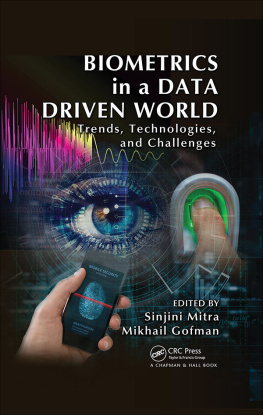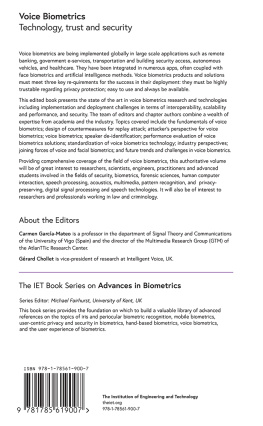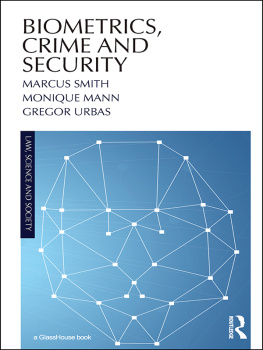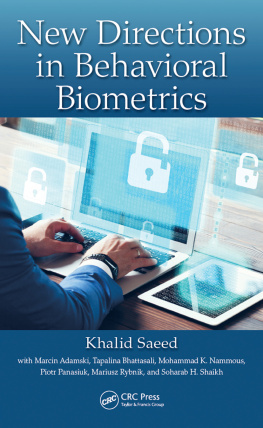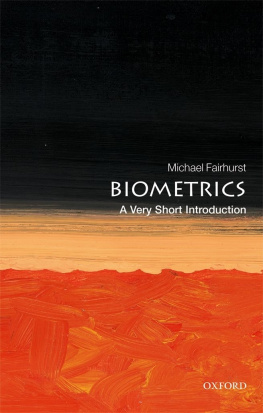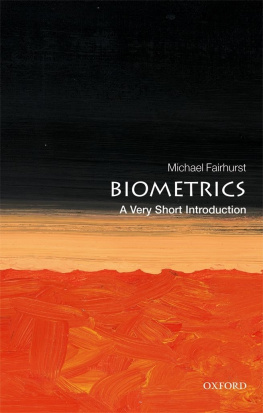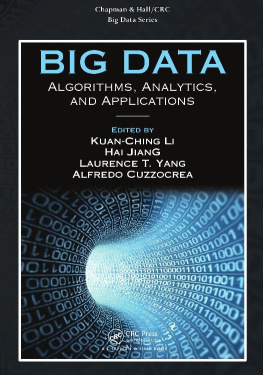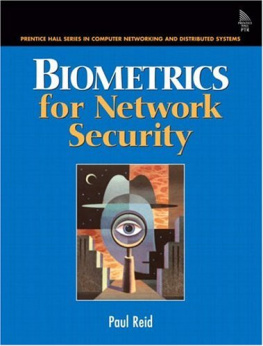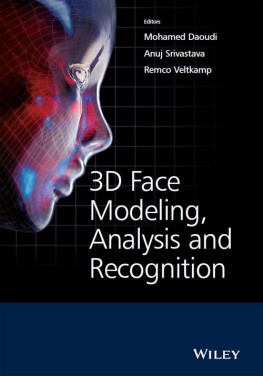BIOMETRICS
in a DATA
DRIVEN WORLD
Trends, Technologies,
and Challenges
BIOMETRICS
in a DATA
DRIVEN WORLD
Trends, Technologies,
and Challenges
EDITED BY
Sinjini Mitra
Mikhail Gofman

CRC Press
Taylor & Francis Group
6000 Broken Sound Parkway NW, Suite 300
Boca Raton, FL 33487-2742
2017 by Taylor & Francis Group, LLC
2017 CRC Press is an imprint of Taylor & Francis Group, an Informa business
No claim to original U.S. Government works
Printed on acid-free paper
Version Date: 20161028
International Standard Book Number-13: 978-1-4987-3764-7 (Hardback)
This book contains information obtained from authentic and highly regarded sources. Reasonable efforts have been made to publish reliable data and information, but the author and publisher cannot assume responsibility for the validity of all materials or the consequences of their use. The authors and publishers have attempted to trace the copyright holders of all material reproduced in this publication and apologize to copyright holders if permission to publish in this form has not been obtained. If any copyright material has not been acknowledged please write and let us know so we may rectify in any future reprint.
Except as permitted under U.S. Copyright Law, no part of this book may be reprinted, reproduced, transmitted, or utilized in any form by any electronic, mechanical, or other means, now known or hereafter invented, including photocopying, microfilming, and recording, or in any information storage or retrieval system, without written permission from the publishers.
For permission to photocopy or use material electronically from this work, please access www.copy-right.com (http://www.copyright.com/) or contact the Copyright Clearance Center, Inc. (CCC), 222 Rosewood Drive, Danvers, MA 01923, 978-750-8400. CCC is a not-for-profit organization that provides licenses and registration for a variety of users. For organizations that have been granted a photocopy license by the CCC, a separate system of payment has been arranged.
Trademark Notice: Product or corporate names may be trademarks or registered trademarks, and are used only for identification and explanation without intent to infringe.
Visit the Taylor & Francis Web site at
http://www.taylorandfrancis.com
and the CRC Press Web site at
http://www.crcpress.com
Contents
SINJINI MITRA, BO WEN, AND MIKHAIL GOFMAN
YOONSUK CHOI
MARIA VILLA, MIKHAIL GOFMAN, SINJINI MITRA, CHRISTOPHER RODNEY, AND MAHDI HOSSEINI
KENNETH KUNG AND LAURIE oCONNOR
CHARLES LI
REGAN L. MANDRYK AND LENNART E. NACKE
MIKHAIL GOFMAN, SINJINI MITRA, MARIA VILLA, AND CHRISTINA DUDAKLIAN
YUN TIAN, MIKHAIL GOFMAN, AND MARIA VILLA
MARIA VILLA AND ABHISHEK VERMA
ANDREY GUBENKO AND ABHISHEK VERMA
RODRIGO MARTINEZ AND ABHISHEK VERMA
ALEC YENTER AND ABHISHEK VERMA
MARIA VILLA AND ABHISHEK VERMA
YUKHE LAVINIA AND ABHISHEK VERMA
JASON LIGON AND ABHISHEK VERMA
YU LIU AND ABHISHEK VERMA
SINJINI MITRA AND BO WEN
Figure 1.10 Images of a person under
various pose variations
Figure 1.11 Images of a person with
various expressions
When studying 31,000-year-old cave wall paintings of prehistoric humans, archeologists occasionally stumble upon a remarkable finda human handprint. It is believed that these prints were left on the walls of caves to serve as the signatures of the artists. This concept of using human traits for purposes of identification eventually evolved into the intricate and subtle field that is known today as biometrics.
The word biometrics originates from the Greek words bio (life) and metric(to measure). In traditional statistical literature, the terms biometrics and biometry have been used since the early twentieth century to refer to the field of development of mathematical methods applicable to data analysis problems in the biological sciences. Some examples include agricultural field experiments to compare the yields of different varieties of a crop and human clinical trials evaluating the relative effectiveness of competing drugs. However, recently the term biometrics has also been used to denote the unique physical traits, such as face, fingerprints, and iris, and behavioral characteristics, which include gait, voiceprint, and signature. Biometric authentication refers to the science and technology of identifying people based on their physical and behavioral traits. Technological advances as well as new discoveries about the human body and behavioral patterns continue to expand the list of human traits that are useful for identification. For example, recent research has demonstrated the viability of using ear prints, brainwaves, heartbeats, and DNA as basis for verifying identity. It is quite surprising, yet fascinating, to see how this field has evolved following the September 11 attacks in New York City in 2001, particularly over the last 1015 years.
In todays highly connected and data-driven world, biometrics play critical roles in ensuring national security and are becoming increasingly important in securing mobile and cloud computing applications, as well as improving the quality of health care and transforming the way people experience computer gaming and entertainment.
The aim of this book is to inform readers about the modern applications of biometrics in the context of a data-driven society, to familiarize them with the rich history of biometrics, and to provide them with a glimpse into the future of biometrics.
discusses the fundamentals of biometrics; provides an overview of common biometric modalities, namely face, fingerprints, iris, and voice; discusses the history of the field; and provides an overview of the emerging trends and opportunities.
introduces the reader to a wide range of biometric applications as noted above.
) currently used on mobile applications. As smartphones and tablet computers are rapidly becoming the dominant consumer computer platforms, biometrics-based authentication is emerging as an integral part of protecting mobile devices against unauthorized access, while enabling new and highly popular applications such as secure online payment authorization.
Finally, concludes with a discussion of the future trends and opportunities in the field of biometrics, which pave the way for advancing research in the area of biometrics and for deployment of biometric technologies in real-world applications.
A recurring theme throughout this book is the challenge of implementing automated biometric authentication. This is because making biometrics-based authentication robust requires complex sensor technologies for capturing high biometric quality images (e.g., face photographs or voice-prints) and complex algorithms, which can accurately determine the identity of a person based on the biometric images. Addressing these challenges is an important area of biometrics research which this book discusses.
The books intended audience includes individuals interested in exploring the contemporary applications of biometrics, from students to researchers and practitioners working in this field. Both undergraduate and graduate students enrolled in college-level security courses will find this book to be an especially useful companion.
Security is of utmost importance today to ensure the safety of the world. From the London bombings of 2005 to the more recent attacks in the airports at Brussels and Istanbul in 2016, there is imminent need to enhance security in different areas. As people will learn from reading this book, biometrics provides a way to accomplish that in many practical security applications.
Next page
